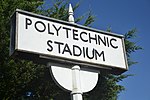Tideway Scullers School
Buildings and structures in ChiswickChiswickLondon stubsRowing club stubsRowing clubs of the River Thames ... and 2 more
Sport in the London Borough of HounslowTideway Rowing clubs

Tideway Scullers School is a rowing club on the Tideway of the River Thames next to Chiswick Bridge in Chiswick, London.The club previously held the headship for the Head of the River Race (2009), the largest UK eights event, and the senior squad holds the record for the Head of the River Fours course.
Excerpt from the Wikipedia article Tideway Scullers School (License: CC BY-SA 3.0, Authors, Images).Tideway Scullers School
Thames Path - Northern Bank, London
Geographical coordinates (GPS) Address Nearby Places Show on map
Geographical coordinates (GPS)
| Latitude | Longitude |
|---|---|
| N 51.473333333333 ° | E -0.26833333333333 ° |
Address
Tideway Scullers School
Thames Path - Northern Bank
W4 2SH London (London Borough of Hounslow)
England, United Kingdom
Open on Google Maps








